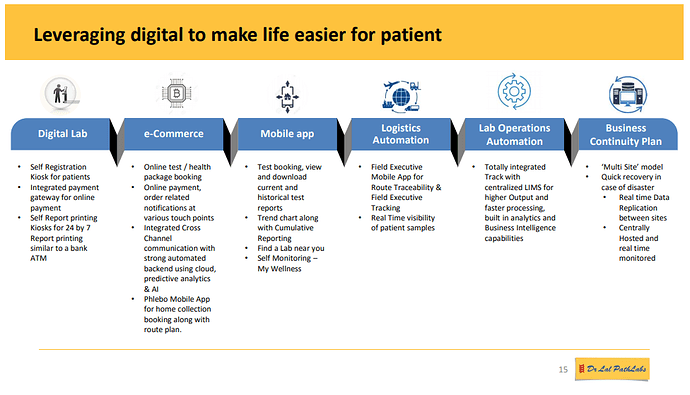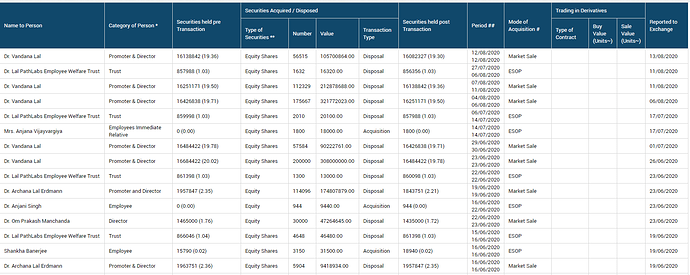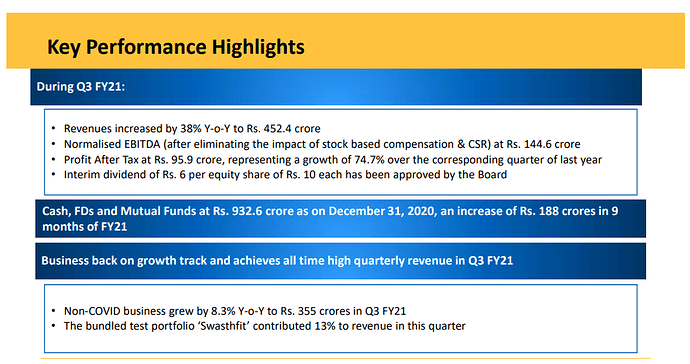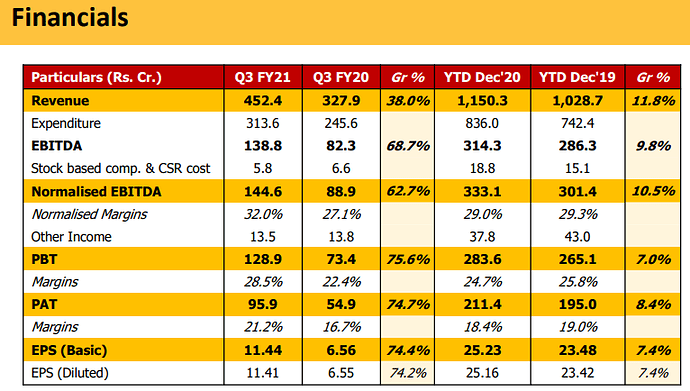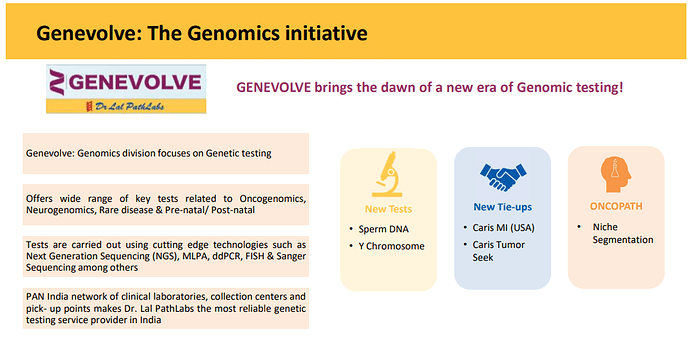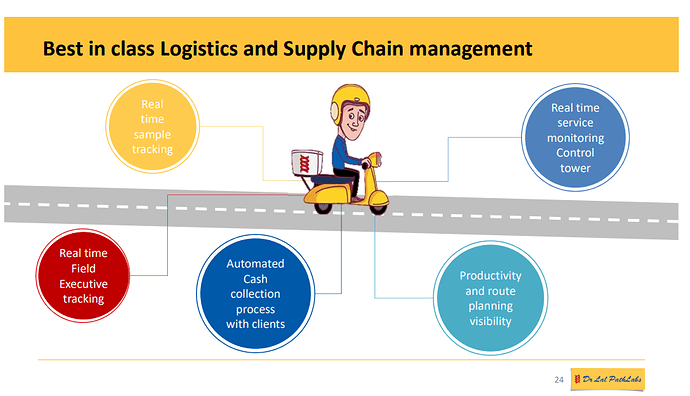Q1FY21 CCT Notes
Non-COVID was hit due to restriction of patient’s movement and logistic hurdles in lockdown.
We are back to 90% of YoY in June, but this could be pent up demand. May not be sustainable.
RT-PCR & Other COVID Tests
When someone is symptomatic, with rapid antigen negative, then only we do RT-PCR. Antibody is a different group of tests. Antibody test should be done in an IGG test. Govt. allowed a mix of IGM and IGG. IGM tells you of the recent infection and IGG tell you of sustainability, surveillance and immunity. So here, it became a problem that if the combined test is positive and the patient is still having symptoms, then in that case also, he should go for the RTPCR test. It is very confusing. In my opinion, the combined test for antibodies should never have been introduced, but again, it was introduced.
Do not know what the future volumes will be.
Contribution of COVID business is 20%, 60% came from govt. Covid will not be very sustainable, govt. is building their capacity. Private business here has been home collection. We would not even encourage them to give COVID samples in labs in person.
Not taking COVID test without prescription pan-India ex Mumbai. There are ICMR guidelines. Anitgen testing is showing high rate of false negatives. We have not seen peaking of cases yet, we are at the initial stages of the epidemic. Antibody tests will start when we see a plateau in new cases.
So once you talk about immunity, so the immunity which matters, as I said earlier is an IGG test. Those people who test IGG positive, they are clear. They will not get this infection and they are not to be put under surveillance, they can actually go and start their work. And there are also good candidates to donate their plasma for plasma treatment. The guys who turn out to the IGG negative, they are the ones especially in the elderly age group, etc., people with co-morbidities, elderly, who are IGG negative, they will become the first candidates to be given the vaccines. And once the vaccines are given, and the vaccines in India may be given once or after 4, 5 months or 3 months, they even might give you a booster and that will also create the IGG antibody. So that is how the system works.
One more thing that a lot of scientists are also advising that this IGG antibody positive does not mean one should have a false sense of confidence that they will last forever, because the life of this immunity is not that long.
Yes, but that is a questionable kind of a thing. Usually, what we have seen from other virus is once the IGG antibody comes in, it stays for a long time out here. Once those studies have been done extensively, we will get the answer. I agree with you. I even read somewhere like this what you are saying.
So, on RT-PCR as we mentioned that 60% of the contribution is from the Government. A lot of Government business by the way, comes as a spillover business because if they are certainly flushed with a lot of samples and they are not able to meet that requirement for that day, then they think of a private guy. I think one must know that Government has built a lot of capacity of testing of RTPCR. So, any business that comes from the Government technically is a spillover. So, it is not a regular flow that one can depend on. And I think only one can depend on is on a private side of business which I mentioned it is coming from either individuals calling up and asking for home collection or it is coming from private hospitals, which to my mind will be a function of how this whole trajectory of infection takes place. Your second question of antibody testing. It is not right now a very significant component of our testing. I think 95% is RT-PCR of our testing in terms of value.
In July COVID tests have softened.
So let me briefly explain to you about this pool testing concept. The pool testing by ICMR was allowed only if the State Government agrees to that, that is number one. So, it is not allowed across the country unless you have an approval from the State Government. And if I am not mistaken, there are also guidelines on this - if the positivity is higher beyond a certain level, then pool testing cannot be done. In fact, there was a time when we did this for one state where we had an approval from that State, but the moment we saw positivity going beyond a particular level, then we said that this is not allowed and so we stopped that. So right now, there is no pool testing happening in our system. It is all individual.
Removal of Prescription guideline from ICMR - I think you probably can answer this question for yourself. The fact of the matter is every test is done has to be reported. So people are very-very cautious in do they really want to get test done. So, I do not think testing is constrained because you have a prescription requirement. Maybe you can ask this question in Mumbai, because that is a great pilot city because Mumbai has taken away this requirement. I really do not know to what extent RT-PCR testing has gone up in Mumbai city. Probably that will answer this question. I also would love to hear as to what really happens if the prescription condition goes away. My sense is it may not be.
COVID Impact
Patients are hesitant to visit any healthcare facility unless absolutely necessary. Demand for home collection is rising. Walk-in is in decline. Large format labs are declining while small collection centers are rising. Crowd is less there. OPDs are down.
Branded players can market themselves as fully compliant in taking precautions against virus infections, and thus we should see a preference over non-branded players.
All labs, collection centers are open now, barring a few days of curfew here and there.
We have to assure our non-COVID patients that we are not collecting or doing COVID tests here.
Actually, our B2C is much more adversely impacted. I think broadly, we have seen two changes. For three dimensions if I look at, one is the geographical mix, second dimension is channel mix and third dimension is test mix. We are not seeing a significant change in our test mix. Maybe a slight deviation towards higher end contribution has slightly gone up. But I really would not call it a very significant change in the test mix. What we have seen is two changes; one is geographical mix. Rest of India actually has done well compared to Delhi NCR. And we have two hypotheses there. We do believe that entire recovery may not be of our own patient base. We do believe that we are waiting for results of other companies. We do believe that we may actually have had a market share gain as well because we do believe that operational excellence was very high in our logistics. So, we will have to wait and watch and do this analysis, but we do believe that some of the gains that we are seeing on non-COVID, it may not be the entire recovery of our own base, it may be also a share gain as well.
The other change that we are observing is a channel mix. The channel especially the walk-in which actually comes from our own infra, because our own infra is a large walk-in format, where on a daily basis, some labs actually have even 200, 300, 400 patients coming in, it is similar to a hospital kind of setup. That actually has taken a significant knock. A lot of it has actually moved into a home collection. So, we have recovered there. Some of it has gone into our collection centers because collection centers also serve them as walk-in patients. But the benefit there is that you do not have a large congregation of patients there. One collection center will have about eight to ten patients, maybe 15-patients a day compared to our own lab walk-ins where it can actually go to 200 as well. So, we are seeing patients’ tendency to go into that area where there is a less crowd. I have a feeling even in hospital, OPDs may have come down. They may actually have moved into a single doctor sort of OPD practice. So that is a change that we are observing.
So, let us say, if I were doing 100 earlier, today, I am doing 90, one can say probably you actually recovered this entire 90 out of your own universe of 100. What I am trying to say is it may not necessarily be true. I may have recovered 80 of my own, but 10, maybe those guys who are in any case not coming to me earlier, maybe going to competition, may have come to me now.
Growth has come from pick up points and I do not count them as B2C.
The RT-PCR testing, and for the benefit of everybody, there are only a handful of labs. Antibody testing I think a lot of this unorganized setup will also do that. Please remember this, if antibody test takes off, it is not only advantage for large labs. It is advantage for all labs. RT-PCR test only happens in large labs. If I were to take out my COVID and then look at non-COVID trajectory for our business, maybe about 8%, 10%, 15% down for them. So, let us say, if we are 90% of non-COVID, they would be about 70% of non-COVID. That is the kind of math probably one can do.
Geographic Mix
Do not see aggressive growth in NCR but North India ex NCR should be good. Kolkata reference lab has come very handy, lots of tests took place in East, and helped us build strong brand equity there.
Corporate B2B Testing
Antibody testing is not a diagnostic test, it does not help to confirm a diagnosis.
Second is let us paint the scenario. A lot of people are talking about it as a test which will help you to restart your workplace. Let us imagine a scenario, you have 1,000 people in your office, and you do antibody testing on a particular day. Now what happens if let us say 100 people are positive, and these positive people are IGG positive because IGM test has not yet come. So 100 people are IGG positive, so probably you will say, okay, these are those guys who actually had the infection. Now they have recovered. They can go inside the office. Now, those 900 who are negative. So what does it mean? Are you telling them, you please turn positive, then only you come to office or if you are negative, you can also come. If you allow them also to come, antibody test actually has not served any purpose at all. Then you allow all 1,000 to come without even doing a test itself. So technically speaking, I think a lot of people are talking about this that this can help you to start office. I am still not very sure as to how does it help. One thing it does actually is that it helps you to do a serosurveillance that if you pick up randomly, let us say, 10,000, 20,000 people in a particular zone and then you say to what percentage of people are actually carrying antibodies, it tells you to what extent infection has spread in a lot.
The other role of antibody would be, it is a general desire for all of us to know whether I actually have developed antibody or not. And that situation may arise once you get vaccine. People would want to know whether antibodies have developed or not. So it is that kind of test value it has. But it definitely does not have a diagnostic value. Now going forward, can it become a very large test in our portfolio? It can, but one should also keep in mind that as antibody testing picks up, there is also a rapid antibody test which is likely to come. And rapid antibody test is like a point of care test, where it does not suit a centralized lab model. So, it will be freely available with a small little prick you can actually do
The other role of antibody would be, it is a general desire for all of us to know whether I actually have developed antibody or not. And that situation may arise once you get vaccine. People would want to know whether antibodies have developed or not. So it is that kind of test value it has. But it definitely does not have a diagnostic value. Now going forward, can it become a very large test in our portfolio? It can, but one should also keep in mind that as antibody testing picks up, there is also a rapid antibody test which is likely to come. And rapid antibody test is like a point of care test, where it does not suit a centralized lab model. So, it will be freely available with a small little prick you can actually do it yourself as well. So one should keep that in mind as these antibody tests come in, there could be a rapid antibody also may come as a part of portfolio.
Margins & Costs
Margins are not stable in COVID tests as the prices are regulated and changing by the govt. The margins are lower than our non-COVID portfolio, we have reduced our costs to manage the margins, it is helping pick the slack of our fixed costs.
Cost of reagents have gone up due to 1. COVID tests reagents are more expensive. 2. As the turnover fell, the scale of testing especially in our satellite lab has come down and we have seen a significant rise in our consumption cost in our satellite lab infra.
If business mix shifts to collection centers, we could see margin pressure ahead. I think the management team will have to be watchful as we go forward because a lot of our fixed overheads is caught up in our lab infra. Lab infra serves two purposes; one is of course of testing which is on supply side. It also serves on fulfilling walk-in demand which is on the demand side. If the demand is going to switch to collection centers and pick up points, so we will have to relook at the cost structure of this lab infra and also role of lab infra. So I think that is a brilliant observation you have and we will have to be watchful on that. I do not want to take a kneejerk reaction here because it may just be very temporary in nature. Otherwise, we will have to probably see how we provide the same brand experience on collection centers. The good news is that our franchisee management has gone up many notches in the last three, four years. So, we are basically focused on providing the same brand experience as we provide in the lab.
Now, coming back to pick up points, see, one of the reasons which I am not sure right now, I can’t say with that kind of confidence, if the patient insists that I want Dr. Lal’s report, you can collect the sample, but I make sure that you give me Dr. Lal’s report. So that could be a great way of capturing that demand in any case because patient might actually go to a neighborhood pick up point or a collection center but still insisting for Dr. Lal PathLabs report because they trust in our brand. So, to my mind, I think that should be good enough. And that also could set up another trend of which we have been talking in the past is that, can these smaller players be aggregated through a collection center model. So, let me not jump to that, but we will have to probably wait and watch as to how landscape changes post this COVID. But I buy your point of first one where the cost structure with walk-in dropping in, we will definitely need to be watchful on that.
Overall margins on RT-PCR tests are much less than our average portfolio margins. So, to that extent, while you may see a very high turnover contribution in the first quarter, but as far as the bottom line contribution is only to the extent of that it covers our fixed cost, it really does not contribute too much to our EBITDA margins. As far as antibody testing is concerned, right now, the contribution of antibody is very, very small. And even in antibody as well, there, as Dr. Lal mentioned, one is IGG-based test, other is total. And we believe from a medical point of view, IGG has much higher value. This total we are a little unsure about as to what value it actually delivers. So right now, I would actually close the comment by saying that antibody test as a contribution to total is not significantly higher for us.
Absolutely, actually, a lot of effort had gone on cost side as well. There are two, three cautions we had. We did not want to take any kneejerk reaction on unnecessarily cutting costs. So, one thing that we took care of our employees, no cuts on that front. And there are two, three areas where we did have some savings; one was A&P because business was not happening for at least one and a half, two months. And then small areas like travel of course got cut for everybody because virtually there is no travel. Repairs and maintenance also, we had some saving. So, on balance, we were able to manage about Rs. 8 to 10 crore of cost savings in the quarter, but we were very cautious in not taking any knee-jerk reaction on unnecessarily cutting costs.
Business Model Developments
In general on a macro level conceptual claim, I think it is something to do with the business model. As we evolved out of Delhi, a lot of our sales used to come from our own infra. A lot of it used to be walking into our labs. But scalability in our model came when we actually got some network effect by opening a lot of collection centers. As the contribution of Delhi NCR is on a decline and contribution from rest of India is on the rise, so a lot of our sales actually end up coming through franchisee collection centers. While the flow of the patients is very similar to what we would see in our own infra, because even collection center also will have two streams - One is walk-in, another is B2B which is pickup in and around that collection center. So, as the proportion of collection center moves up in the business, you will actually end up seeing a higher payout to collection centers.
Going forward, I do believe that proportion of sales coming from collection center network will tend to rise. And that is a great way to grow the business as well, because it variabilizes your costs. In fact, we are learning this particularly in this quarter when our walk-in business drops and a lot of our costs are locked in overheads in our labs. It is always good to see how we can variabilize our costs. So, I think franchisee model actually gives us that insurance. And it also augurs very well for us as we expand our footprint in rest of India. So, directionally, this number will tend to rise as our contribution from collection center goes up. On a specific quarter-to-quarter change, I think directionally, that is the way you should look at it.
In fact, as we compare Delhi NCR versus rest of India, there may be slightly different revenue share, which is like Delhi has 20%, outside Delhi NCR it might be 20%, 25% and as rest of India is growing faster and the contribution is also high. So, revenue is coming from rest of India where realization is also lower than Delhi NCR. And as a percentage of revenue, it tends to go up. So, that is where one has to see.
I think broadly speaking, since our throughput per collection center in rest of India is slightly lower, just to keep the viability in mind, and also in Delhi NCR, we provide doorstep pick up service, which does not happen in case of outstation CC, so we end up giving a slightly higher margin to them, so which is maybe to the extent of about 5%, 6% higher than Delhi average.
A lot of people are now reaching out through online booking, etc., but we have actually started using our franchisee network to do home collection because so far if I were doing 100 home collections, a lot of it actually were being serviced by us directly. But since the demand in the recent past actually has gone up multi-fold, and it is not a scalable idea that if I build my own team of home collection because that is actually working against the whole philosophy of scaling up through franchisee network. So, we are looking at engaging with franchising quite a bit, but that engagement with franchisee has to be done through technology because we also want to control the entire experience of home collection. And leaving it loose, we may actually lose the control on the experience because in our industry the real brand experience actually is the contact of a phlebotomist with the patient. And in some way, I do not want to dilute that. I really want to keep a very big supervision on that experience. So, we are taking help of a technology, and that is where I think this whole tech business is going to come very handy here where we are able to integrate our franchisee network, where we have somewhat a direct control on the entire brand experience that happens through home collection.
If I go back to my FMCG experience of Hindustan Unilever, I would rather increase the throughput per PSC rather than looking at just the number of PSC count. There are two parts of this business as you guys have understood this: one is the testing bit. A lot of economies of scale have to come from testing and which is what our real strength is. And it can be centralized. But the challenge lies on the collection part of the business which has to be more decentralized, closer to patients. Home collection is making it even worse where virtually every guy wants home collection to be done and it is so customized. And so that piece actually needs to be handled by a franchisee network. And I would rather try to build economies of scale at a franchisee level rather than fragmenting it. So, to my mind, aimlessly chasing this number of PSC may not be a great idea. But obviously, it is a fine balance between what is the kind of productivity I may want to have on PSC front. But broad thumb rule that we normally follow for our lab to PSC ratio, it is about 1:19, 1:20. If I can maintain that ratio going forward, would be a great thing to happen.
Patient Data Monetization
The data is very confidential and we are very hesitant to share this information with anyone. Not looking to monetize.

